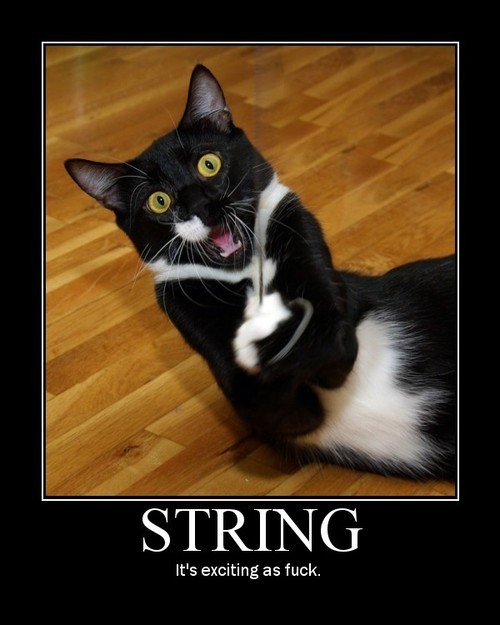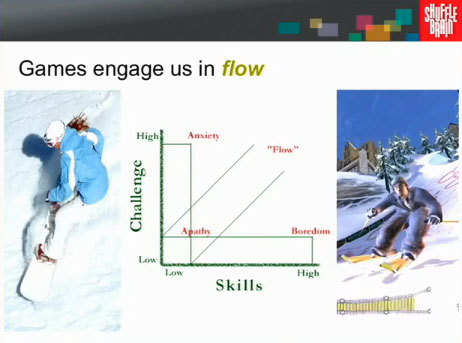What Mr. Tibbles Can Teach You About Game Mechanicst
What Mr. Tibbles Can Teach You About Game Mechanicst

Consider this a teaser to my upcoming post on Game Mechanics that will blow your balls away. That being said, this post is about Cats.
I know what you’re thinking, “If this foo’ starts typing in that annoying ‘Ohz noz, I gotz too muchz timez on meh paws andz is retardizly tuz involved wiz catz’ text than I’m outta here.” Good call. I wouldn’t do that to you. I’ll leave that task to your creepy co-worker who talks about how Mr. Tibbles likes his gourmet tuna slightly heated with carrot peels and a smidgen of rocky road ice cream. No, this post is much more relevant to software. Specifically, game mechanics.
Cat String Theory
Cat String Theory is the theory of attention. When you dangle a piece of yarn in front of a cat, it pounces. It stands on it’s two hindz legz (had to do it) and starts knocking it around like it’s a punching bag. If you let the string go, it gets bored and walks away. Here’s where it gets interesting. If you raise the string up to high and never allow the cat get a victorious snag, it will also lose interest. However, if you intermittently lower the string, stop the string, and move the string in a random fashion, the cat goes nuttier than squirrel turds. Your cat-obsessed coworker is right - there’s more to Mr. Tibbles than a luscious coat and diva attitude. That little bastard can teach us something about our motivations.
Our Motivations
Like cats, we’re motivated by a nice petting in a cozy area. We’re also motivated by feedback and challenge. If you let the string lie in front of the cat, they’ll walk away. It’s too easy. Same with us, I don’t go wasting my time stacking bricks because I get nothing out of it. If you never let the cat touch the string, then the cat is getting no feedback for all of it’s effort. That’s when Mr. Tibbles gets mad and stomps away to go piss behind the sofa. If you tell me you have a game where I get to stack bricks, and when I start, you constantly knock down the stacks, I’m also seeing no results for my effort. I’m getting no feedback. Like Mr. Tibbles, I’ll stomp away and go piss behind your sofa.
Now, add some proper game mechanics. Wager me 2 to 1 odds against stacking the bricks into ten 3x3 foot walls in twenty minutes, with no foul play. My interest has peaked. So what did you do:
- Goal/Feedback: You added a specific goal with the 3x3 ft brick wall. When I start seeing my walls pile up, I’m getting feedback. I’m seeing results for my efforts.
- Challenge: You made it challenging for me by adding a the parameter of a time restraint.
- Reward: You added a reward to the equation by wagering
Make no mistake, these mechanics have to be integrated with context in mind. If you wager me to do this in 10 seconds, I’ll walk away.
Also, the reward for the cat is intrinsic. That moody Mr. Tibbles loves to beat the shit out of a piece of string. Probably because Janice dresses him in tiny cat sweaters. Intrinsically, I might play the game because I like to win or feel a sense of accomplishment. But having another motivator doesn’t hurt especially if it adds to the players social status within the game/network. When that status goes up, that player becomes even more vested in their game persona. Having the correct balance of challenge is elaborated in the book Flow.
Flow

The book Flow talks about engaging the player. Flowstates:
- If the skills of the player are high and the challenge is low, then this leads to boredom. The cat walks away from the lifeless string.
- If the skills of the player are low and the challenge is high, then this leads to anxiety. The cat is never able to touch a string that is dangled way too high and quits out of frustration.
- If the skills and challenge start low and progressively get higher and higher, then this keeps the player engaged.
The Take Away
Mr. Tibbles has taught us a lot about engagement within Game Mechanics:
- A progressive and symbiotic skills to challenge ratio is the best combination to hold interest.
- Players need to see some sort of feedback that shows their efforts are paying off.
So next time you see a cat, put the theory to the test. Then give them some cat nip and cover your genitals.
If you liked this post, you may like:
-
Are You a Commodity? Foursquare > Facebook Location
-
What Monopoly Can Teach Us About Business
-
Selling Is All About Relationship
-Brian
If you made it this far, you should follow me on Twitter. Follow @jprichardson
-JP